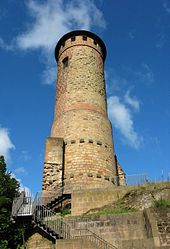Kirkel Castle
| Kirkel Castle | ||
|---|---|---|
|
Ruins of the castle in Kirkel |
||
| Creation time : | around 1075 | |
| Castle type : | Höhenburg, location | |
| Conservation status: | ruin | |
| Standing position : | Count | |
| Place: | Kirkel-Neuhäusel | |
| Geographical location | 49 ° 16 '59 " N , 7 ° 14' 25" E | |
| Height: | 307 m above sea level NHN | |
|
|
||
The Kirkel Castle is a ruined castle in Saarland , which is roughly halfway between the cities of St. Ingbert , Homburg , Neunkirchen and Zweibrücken . It stands on the Schlossberg, a free-standing red sandstone rock. Today, the ruins are the landmark of the district Kirkel-Neuhäusel the municipality Kirkel and a popular destination.
Geographical location
The hilltop castle is 307 m above sea level. NHN . The next river is the Blies , which flows about 5 kilometers east of the castle through the districts Limbach and Altstadt , which belong to the same municipality . The Kaiserstraße runs nearby .
history
1075 was the first mention of a Count Gottfried von Kirkel. At the beginning of the 12th century the castle came into the possession of the Counts of Saar Werden . When the castle was divided in 1212/14, it came under the Saar Werden-Kirkel line. In 1242 Count Heinrich I von Saar Werden-Kirkel died childless. Its property was shared by his nephews, including Arnold and Johann von Siersberg. The Kirkel Castle came to Johann von Siersberg, who called himself "von Kirkel" in 1250. He and his descendants, the lords of Kirkel , achieved imperial immediacy and owned the castle as an imperial fief until the line died out in 1386. In the 13th century the small and round towers were built and in the 15th century the village of Kirkel was built under the protection of the castle.
Between 1410 and 1689 the castle was owned by the dukes of Pfalz-Zweibrücken . From 1580 to 1596 the castle was converted into a residential palace by Duke Johann I. When he was advised against the fact that an enemy could shoot into it from the hill overlooking the castle, he replied: “I will shoot even more from the inside”. In 1635 the castle was badly destroyed by fire and rebuilt, in 1677 the castle was destroyed again in the Franco-Dutch War . In 1689 there was the next destruction in the Palatinate War of Succession .
From around 1740 the ruins were used as a quarry. In 1955 the round tower was rebuilt; he was provided with a tower hood. Archaeological excavations since 1994 have brought more detailed information on the building history, the former appearance and the equipment of the castle.
Todays use
Today the ruin serves as a destination, the 32 m high keep as a lookout tower . Below the castle there is a local museum, a stone carving workshop, a wood workshop, a forge and a sewing room. An archaeological research facility has existed since 1994.
literature
- Christel Bernard in: Jürgen Keddigkeit , Ulrich Burkhart, Rolf Übel (eds.): Palatinate Castle Lexicon. Volume 3: I-N . Institute for Palatine History and Folklore, Kaiserslautern, Kaiserslautern 2005, ISBN 978-3-927754-54-6 , pp. 143–158.
- Christel Bernard: How do you heat castles? Stove tile finds from Kirkel Castle , 2012. ( Online )
- Christel Bernard: Where to get to the bottom of things: The fountain of Burg Kirkel , 2019. ( Online )
Web links
- Entry on Castle Kirkel in the scientific database " EBIDAT " of the European Castle Institute
- Castle summer at Kirkel Castle
- Burg Kirkel History of the castle, photos and reports on the excavations on zeitensprung.de
- Burg Kirkel Brief tourist information about the castle on burgenwelt.de
- Page about the Imperial Castle of Kirkel
- Reconstruction drawing by Wolfgang Braun
Individual evidence
- ^ Julius Wilhelm Zincgref : Der Teutschen Scharpfsinnige Kluge Sprüch / Apophthegmata called , Strasbourg 1639, p. 129
- ↑ Object data on Kirkel Castle in the scientific database " EBIDAT " of the European Castle Institute, accessed on September 17, 2016.


